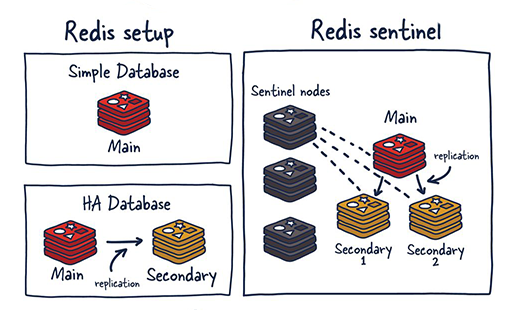Redis, among the various databases, has emerged as a powerful player. Moreover, in today’s ever-evolving technology landscape, where data drives decisions, databases have become the backbone of numerous applications. This article delves into Redis database advantages, exploring its strengths and comparing its design philosophy with other databases.
Redis 101

Redis, short for REmote DIctionary Server, is an open-source, in-memory data structure store that serves as a database, cache, and message broker. Additionally, it is renowned for its exceptional performance and efficiency in handling data. Here’s a brief overview:
In-memory Storage
Redis stores data in the system’s main memory (RAM), allowing for lightning-fast read and write operations, a significant database advantage.
Data Structures
Redis supports a variety of data structures, including strings, lists, sets, hashes, bitmaps, hyperloglogs, and geospatial indexes.
Persistence
Despite being an in-memory database, it offers various methods to persist data on disk without compromising its high speed, ensuring data durability and recovery.
Replication & High Availability
Redis supports master-slave replication and employs Redis Sentinel for high availability and monitoring.
Partitioning
Redis allows horizontal partitioning or sharding, dividing the dataset into smaller chunks across multiple instances.
Atomicity
Redis ensures atomic operations, preventing data corruption when multiple clients access concurrently.

Extensibility: Redis modules enable users to extend its capabilities, with popular modules like RediSearch, RedisGraph, and RedisJSON.
Versatility: Redis serves a wide range of use cases, including caching, real-time analytics, geospatial data analysis, and acting as a message broker through its Pub/Sub feature.
In essence, it is a versatile, high-performance tool popular among developers for a myriad of applications, particularly when high speed and real-time operations are crucial.
Benefits of Redis
Redis stands out from many other key-value stores because of its rich set of data structures. These data structures provide the foundation for building diverse applications with optimal performance. Let’s delve deeper into these data structures:

Strings
This is the simplest data type in Redis, representing a sequence of characters or bytes. While it might seem basic, strings in Redis can hold large amounts of data (up to 512MB), making them ideal for implementing features like counters using commands like INCR.
Lists
Redis lists are ordered collections of strings, particularly useful for storing lists of items, such as user feeds. Commands like LPUSH, RPUSH, LPOP, and RPOP facilitate manipulations at both ends of the list.
Set
A Redis set is an unordered collection of unique strings, with basic operations like adding, removing, and checking element existence being extremely fast. Furthermore, sets support operations like union, intersection, and difference using commands like SUNION, SINTER, and SDIFF.
Sorted Sets (or Zsets)
Similar to sets but with an associated score, making them invaluable for leaderboards, time-series data, and applications where order and ranking matter.
Hashes
Redis hashes are maps between string fields and string values, perfect for representing objects. For example, a user with fields like ‘name,’ ‘age,’ and ’email’ can be represented as a hash in Redis.
Bitmaps
Redis provides commands that allow strings to be used as arrays of bits, useful for tasks like counting unique things, filtering, and caching.
HyperLogLogs
These provide probabilistic cardinality estimation, allowing you to count unique elements in a set using minimal memory.
Geospatial Indexes (or Geo)
Redis offers commands to store, update, and query points in a geospatial index, beneficial for location-based features.
Streams
Introduced in Redis 5.0, streams are a log data type ideal for capturing and querying data elements in an append-only fashion, essential for event-driven architectures.
The beauty of Redis lies in its flexibility, enabled by these diverse data structures. Developers can implement various features like caching, messaging, analytics, and more with considerable efficiency. Each data structure is optimized for specific use cases, ensuring high performance while also minimizing resource utilization.
Redis vs. Other Databases: Contrasting Design Philoscophies
Redis, since its inception, has always been different from traditional relational and many NoSQL databases. Its architecture, data structures, and use-cases have made it a unique offering in the database world. Let’s take a closer look at how Redis’s design philosophy contrasts with that of other databases:
In-Memory vs. Disk Storage
Redis: Primarily operates as an in-memory data store, prioritizing speed over durability, an advantage.
Other Databases: Traditional databases like MySQL, PostgreSQL, and MongoDB rely heavily on disk-based storage.
Data Structures
Redis: Provides a rich set of data structures that can be leveraged to solve complex problems efficiently.
Other Databases: While relational databases operate on tables, rows, and columns, many NoSQL databases, like MongoDB, use document-based models without native data structures like Redis.
Versatility
Redis: Is often termed as a ‘data structures server’ due to its versatility, serving multiple purposes.
Other Databases: Most databases are designed with specific primary functions in mind.
Consistency and Durability
Redis: In-memory nature may prioritize speed over durability by default, though it offers persistence options.
Other Databases: Traditional RDBMSs emphasize ACID properties, ensuring data consistency and durability.
Scaling
Redis: Employs master-slave replication and Cluster for scaling.
Other Databases: Databases like Cassandra or MongoDB were designed with horizontal scaling in mind.
Community and Ecosystem
Redis: Boasts a vibrant community with a rich ecosystem of client libraries, tools, and extensions.
Other Databases: While many databases have strong communities, they may not offer the same level of extensibility.
Redis Use Cases
Real-Time Analytics
Websites with high traffic often require real-time tracking of user behavior, such as pages viewed, time spent on each page, and click-through rates. Given Redis’s rapid data-processing capabilities, it serves as an excellent tool for such analytics. With its Sorted Sets, it’s possible to rank and retrieve data in real time.
Gaming
Online multiplayer games require constant updating of leaderboards, player stats, and scores. Additionally, it provides the ability to handle thousands of write and read operations per second, making real-time gaming analytics a breeze.
Caching
For web applications that see repeated queries, using Redis as a cache can significantly reduce the load on the primary database, be it SQL or NoSQL. Data fetched from the primary database can be stored, and subsequent requests can be serviced from the cache until it expires or is invalidated.
Full Page Caching
Entire web pages or parts of them (like HTML fragments) can be cached using Redis, leading to quicker page loads.
Session Storage
Web applications often store user session data. With its in-memory storage and fast access times, provides a perfect solution for session storage, outperforming traditional disk-based solutions.
Message Brokering & Task Queues
PUB/SUB mechanism can be used for implementing real-time messaging systems. Moreover, structures like Lists make it suitable for implementing queues.
Background Jobs
Systems like Resque and Sidekiq use Redis to queue jobs for background processing.
Chat Applications
Real-time chat applications can benefit from Redis’s Pub/Sub model to broadcast messages to connected users instantly.
Real-time Collaboration Tools
Collaborative tools, like document editors where multiple users can edit simultaneously, require a system that can handle concurrent changes and merge them in real-time. With its real-time processing capabilities, can be used to implement such features effectively.
Geospatial Analysis
It has geospatial capabilities, with commands that support the storage and querying of geospatial data. This feature is beneficial for location-based services like “Find restaurants near me” in food delivery apps.
Rate Limiting
APIs or web endpoints often need rate limiting to prevent abuse. Using Redis’s data structures, like the sliding-window algorithm with Sorted Sets or the token bucket with simple key-value pairs, applications can implement efficient rate limiters.
Shopping Carts
E-commerce websites can use this database to manage shopping carts, especially for high-traffic sites where the speed of adding or removing items from the cart is crucial.
In Conclusion:
Redis, with its high performance and diverse offerings, distinguishes itself in the database realm. It’s essential to assess an application’s requirements and possibly consider a hybrid approach. Integrating Redis with other databases can offer an optimal solution, leveraging strengths from each. Understanding the tools and their capabilities is pivotal in architecting efficient, scalable systems.
—
What’s Next
Idea Theorem is an award-winning Software Development Company headquartered in North America, specializing in Web Design and Development, Mobile App Development, and beyond. Through a user-centric approach, we’ve meticulously crafted digital solutions.
Our dedication is to pioneer the digital frontier by delivering exceptional solutions. Contact us to know more; we’re here to guide you through the development journey.






